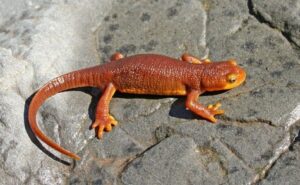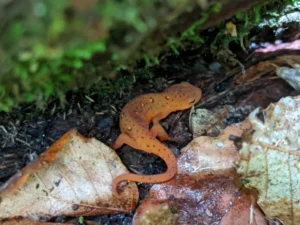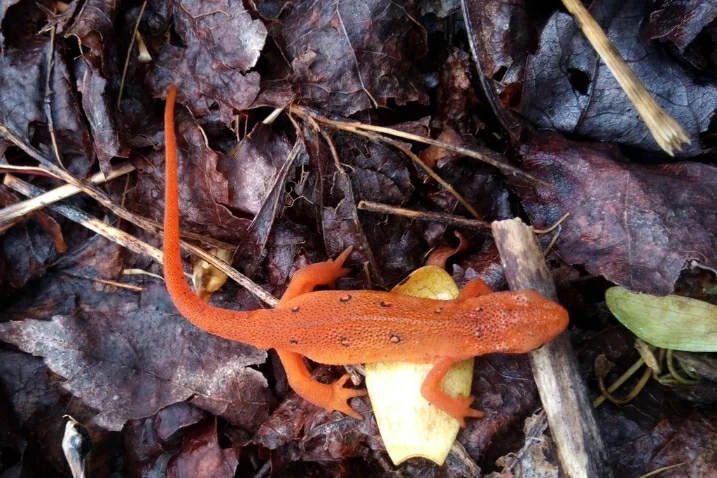You’re walking along the edge of a quiet forest pond, and something bright catches your eye. A tiny creature with a bold orange body crawls slowly over a wet log. You stop and wonder: is this little orange newt poisonous?
Yes, many orange newts are poisonous, but mostly only mildly for humans. Their bright color warns predators that their skin has toxins. These chemicals can make predators sick or taste bad. For humans, it usually just causes mild irritation if you touch them without being careful.
Newts are really interesting because their poison is part of a survival system that’s been working for millions of years.
Which Newt Species Are Orange?
When you think of orange newts, the Eastern newt probably comes to mind first. Its young form, called a red eft, is bright orange with small black spots.

You can see these little efts in summer forests, slowly moving across mossy logs or wet leaves.
Another one is the California newt. It’s darker orange or reddish-brown but still makes skin toxins and uses its bright color to warn predators.

Bright orange newts are mostly in North America. Some species change color as they get older, usually getting darker when they go back to water.
That makes sense because adults spend more time in water and hide under rocks and plants instead of relying on their color to warn predators.
Basically, if you see a small, bright orange newt on land in the summer, it’s probably a red eft, and that’s when it’s most poisonous.
Why Bright Colors Warn Predators About Poison
The bright orange color isn’t just for looks. It’s a warning, a message to predators: “Don’t eat me, I’m dangerous.” Scientists call this aposematism, which just means bright colors show that an animal has poison.
Birds, frogs, and small mammals quickly learn that brightly colored animals often taste bad or make them sick.
A little bird might peck at a red eft, taste the poison, and then leave it alone. After that, it usually avoids them.

Bright colors save the newt energy too. Instead of hiding all the time or running from predators, the newt just sits there and shows its warning.
Even in a crowded forest, this simple color and poison system helps orange newts avoid getting eaten.
How Orange Newts Make Their Toxins
Orange newts make chemicals called tetrodotoxins in their skin. These toxins can stop nerve signals in predators’ muscles, making them sick, numb, or unable to move.
This works really well on small animals like frogs or snakes.
Tetrodotoxin sits in special skin glands. When a predator bites or touches the newt, the glands release the poison like a chemical shield.
The newt doesn’t have to fight, the poison does the work.
What the newt eats matters too. Newts that eat certain insects or tiny animals make more toxins. So their food is directly linked to their survival tools.
Are Newt Poisons Dangerous to Humans?
You might be thinking, “If it poisons a snake, can it poison me?” Actually, the amount in one newt is tiny for humans.
Touching a newt can cause mild skin irritation or numbness if it gets into a cut. If it gets into your eyes or mouth, it can be more serious.

Eating a newt is really dangerous because the toxins are strong enough to affect you inside. That’s why people never eat them.
Watching them from a distance is safe, but touching them needs care.
How Predators Learn to Avoid Poisonous Newts
Orange newts don’t have to fight all the time. Their poison and bright colors teach predators a quick lesson.
A little snake or frog might try to bite, taste the toxin, and spit the newt out. After that, most predators avoid them completely.
Some predators have adapted and can eat red efts without harm. Certain garter snakes, for example, can handle the poison.
But for most animals, the poison works perfectly to keep them away.
Why Red Efts Are More Poisonous Than Adults
Red efts (the bright young stage of the Eastern newt) are far more poisonous than adults. That’s because they spend more time on land, where predators are around. Adults go back to water, hide more, and rely less on poison.
The bright orange color of red efts isn’t just pretty, it shows predators that they’re really toxic.
Adults darken and blend in with aquatic plants, using camouflage as extra protection.
Basically, the brighter the newt, the more dangerous it is to predators. This is especially true for young efts living on land.
How to Handle Orange Newts Safely in Nature
It’s tempting to pick up a bright orange newt, but handling them without care is risky for both you and the newt.
Here are some tips:
-
Use gloves if you have to touch a newt. It stops skin irritation.
-
Wash your hands really well afterward to remove toxins.
-
Keep your hands away from your face and eyes. The poison can irritate your eyes, nose, or mouth.
-
Watch instead of touching whenever you can. Seeing them in the wild is safe and often more fun.
Even though most newts are only a little poisonous to humans, respecting their poison is very important. They’re delicate, and rough handling can stress them or lower their toxin levels.
Do Orange Newts Stay Poisonous All Year?
Newts don’t release the same amount of poison all the time. They make more when they’re stressed or predators are nearby.
If a newt is sitting quietly under a log, it might not release much. But if you disturb it, the glands can release toxins fast.
Seasonal changes also matter. In winter, when predators are less active, newts may make less poison. This helps them save energy to survive colder months.
How Poison Helps Newts Survive and Reproduce
Poison isn’t just for defense, it also helps newts find mates. Bright colors attract partners, especially for red efts.
The brighter and healthier the skin, the better chance a newt has to find a mate.
During breeding season, males show off their colors and fan their tails to look strong.
Predators may still be around, but the mix of warning colors and real poison gives newts a better chance to survive long enough to reproduce.
So, the poison is part of a full survival toolkit: it keeps them safe, shows mates they’re healthy, and helps the species continue.
Are Orange Newts Safe as Pets?
Some people keep orange newts as pets. They’re beautiful and interesting, but their skin poison means handling takes care.
Gloves are recommended, and you should wash your hands after touching them.
Pet owners also need to give a good environment. Clean water, hiding spots, and the right temperature make a big difference.
Stress can lower their poison, making them more vulnerable.
Even with care, watching pet newts in a tank can show you how they hunt, swim, and interact.
They’re small, delicate, and smart about using chemicals to survive.
Conclusion
So, are orange newts poisonous? Yes, mostly to predators. Humans are usually safe if they watch from a distance and handle them carefully.
Their bright color and poison are a clever survival strategy. They help newts avoid being eaten, attract mates, and live in a world full of dangers.
Watching them in the wild shows just how clever nature is.
Next time you see a tiny orange newt on a log or in a pond, take a moment to watch it.
Enjoy its color, its poison, and the small survival systems that make this little amphibian amazing.
Hi, my name is Ezra Mushala, i have been interested animals all my life. I am the main author and editor here at snakeinformer.com.

